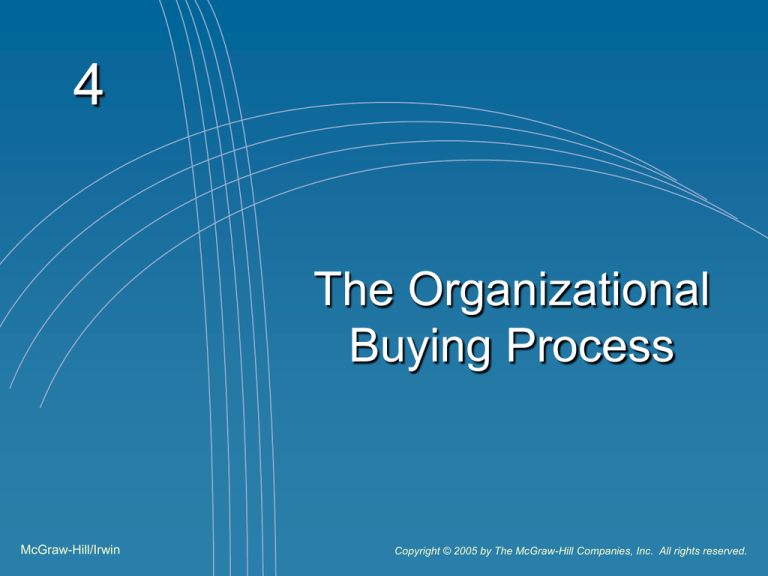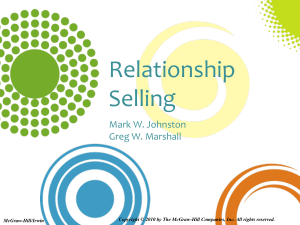
4
The Organizational
Buying Process
McGraw-Hill/Irwin
Copyright © 2005 by The McGraw-Hill Companies, Inc. All rights reserved.
Agenda
Objectives of Business Buyers
Profile of a Professional Buyer
The Changing Role of the Buyer
The Business Buying Process
Business Buying Situations
The Buying Center
The Materials Management Concept
Purchasing and the Internet
Environmental Forces and Buying Decisions
Purchasing's Impact Upon Company Profit
4-2
Typical Job Ad
Square D Company has a Buyer position
available at the Asheville, NC, location. Square
D is a manufacturer of electrical control
products. Responsibilities include: developing,
communicating, and implementing strategies
and tactics to establish, manage, and improve
all aspects of supplier performance; acting as a
liaison between the external supplier base and
manufacturing operations; analyzing and
developing strategies to manage commodity
availability and pricing market conditions.
(continued)
4-3
Typical Job Ad
Prefer a BS degree in business with knowledge of
a JIT environment. CPM or APICS certification a
plus. Experience in value analysis required. This
position requires a highly motivated self-starter
with excellent verbal and written communication
skills and strong computer experience.
4-4
Objectives of Business Buyers
Product availability
Reliability of sellers
Consistency of quality, delivery, and
price
4-5
The Changing Role of the Buyer
Relationship Marketing
a.k.a. alliances or strategic
partnerships
Process where a firm builds longterm alliances with prospective and
current customers so both sides can
work toward a common set of goals
Intraindustry and Interindustry
alliances possible
4-6
The Changing Role of the Buyer
Value Analysis
The task of studying a product and
all of its components in order to
determine ways to produce it at a
lower cost, to improve its quality, or
to make it with a material in greater
or more stable supply
-or Finding the best way to do a job at
the lowest possible cost
4-7
The Changing Role of the Buyer
Make-or-Buy Analysis
An analysis that determines which
products should be made in-house
and which should be purchased.
4-8
The Changing Role of the Buyer
Steps in Value Analysis: Comparison of
Function to Cost
• Select a relatively high-cost or high-volume
purchased item (part, material, or service).
• Find out how the item is used and what is
expected of it - i.e., its function in detail.
(continued)
4-9
The Changing Role of the Buyer
Steps in Value Analysis: Comparison of
Function to Cost
• Ask the following questions:
Does its use contribute value?
Is it cost-proportionate to usefulness?
Does it need all its features?
Is there anything better, at a more favorable price, for the
intended use?
Can the item be eliminated?
If the item is not standard, can a standard item be used?
If it is a standard item, does it completely fit the proposed
application, or is it a misfit?
(continued)
4-10
The Changing Role of the Buyer
Steps in Value Analysis: Comparison of
Function to Cost
• Ask the following questions:
Does the item have greater capacity than required?
Is there a similar item in inventory that could be used
instead?
Can the weight be reduced?
Are closer tolerances specified than are necessary?
Is needless machining performed on the item?
Are unnecessarily fine finishes specified?
Is commercial quality specified?
Can you make it now? Can you buy it for less?
If you are making it now, can you buy it for less?
(continued)
4-11
The Changing Role of the Buyer
Steps in Value Analysis: Comparison of
Function to Cost
• Ask the following questions:
Is the item properly classified for shipping purposes to
obtain the lowest transportation rates?
Can the cost of packaging be reduced?
Are you asking your suppliers for suggestions to reduce
costs?
Do material, reasonable labor, overhead, and profit total
the item’s cost?
Will another dependable supplier provide it for less?
Is anyone buying it for less?
4-12
The Changing Role of the Buyer
Steps in Value Analysis: Comparison of
Function to Cost
• Now:
Pursue those suggestions that appear
practical.
Get samples of the proposed item(s).
Select the best possibilities and propose
changes.
4-13
The Changing Role of the Buyer
Negotiation
4-3
4-14
The Changing Role of the Buyer
Centralization Versus Decentralization
of the Buying Function
•
Centralized purchasing
Advantages = standardization of purchased
parts, administrative duplication eliminated or
reduced, order quantities can be increased,
buyer has better control over purchase
commitments, fosters development of
specialization and expertise.
Disadvantages?
4-15
The Changing Role of the Buyer
Centralization Versus Decentralization
of the Buying Function
•
Decentralized purchasing
Advantages = less inventory is required, cost
may be lower due to local economic
conditions, local buyers and sells can
develop a relationship, buyers create
impression of being a good corporate
customer and neighbor
Disadvantages?
4-16
The Business Buying Process
Recognizing the need
Developing product specifications
Soliciting bids from potential suppliers
Making the purchase decision
Issuing the contract
Inspecting delivered goods for quality
Evaluating vendor performance
4-17
Quotations and Contracts
RFP: Request for Proposal
RFQ: Request for Quotation
Boilerplate: Standard legal clauses (fine print) on RFQs, your
bid, and the customer’s order. May contain terms of sale that
contradict terms on your bid, and often contain penalties for
nonperformance.
You may receive an RFP, send a proposal, receive an RFQ,
send a bid, receive an order, and ship products with an
invoice.
A contract may be involved for long-term requirements.
If company-to-company EDI is used to order, customer’s
boilerplate may be sent once per year.
Internet purchases give seller an advantage, in that seller’s
boilerplate terms are presented, but not customer’s. A wise
buyer might add a reference to them.
4-18
Evaluating Potential Vendors
Basic Considerations in Evaluating Potential
Vendors
•
•
•
•
Performance Considerations
Site Visits
Geographic Locations
Capacity
Vendor-Rating Approaches
• The Categorical Plan
• The Weighted-Point Plan
• The Cost-Ratio Plan
4-19
Business Buying Situations
New-task buying: Business buying situation that is
new and very different from anything that the buyer
has faced previously.
Straight rebuy: Most common type of business
buying situation; buyer purchases a part, material, or
service routinely, with little thought going into buying
process.
Modified rebuy: Reevaluation of alternatives;
necessary because buying requirements have
changed such that relatively routine buy or purchase
no longer is routine.
4-20
4-7
A requirement or
problem that has not
arisen before. Little or
no relevant past
buying experience to
draw upon.
A great deal of
information is needed.
Must seek out
alternative ways of
solving the problem
and alternative
suppliers.
Continuing or
recurring
requirement, handled
on a routine basis.
May develop from
either new task or
straight rebuy
situation.
Usually the decision
on each separate
transaction is made in
the purchasing
department.
The requirement is
continuing or recurring,
or it may be expanded
to a significantly larger
level of operations.
Formally or
informally, a list of
acceptable suppliers
exists. No unlisted
supplier is considered
The buying alternatives
are known, but they
are changed. Some
additional information
is needed before the
decisions are made.
4-21
4-7
4-22
4-9
4-23
4-9
4-24
The Buying Center
Roles of Buying Center Members
User: Person who will use the product in question; influence
can range from minimal to major.
Gatekeeper: Keeps tight control on flow of information to
other buying center members; can open or close the gate for
salespeople.
Influencer: Provides information to other members for
evaluating alternative products or sets purchasing
specifications
Decider: Makes buying decision; often difficult to identify.
Buyer: Assigned formal authority to select vendors and
complete purchasing transaction.
4-25
The Materials Management Concept
Materials management (a.k.a. logistics):
Grouping of functions involved in
obtaining and bringing materials into a
production operation.
Usually one manager responsible for
planning, organizing, motivating, and
controlling all the activities principally
concerned with the flow of materials into
an organization.
View material flow as a system.
4-26
The Materials Management Concept
Approaches to Materials Management
• Traditional Approach
• Just-in-Time (JIT) Approach
• Integrated Supply Strategies
Reasons for Adopting the Materials
Management Concept
• Improved communication and coordination
between departments
Can balance conflicting interests
Faster, smoother material flow
Lower inventory and logistics costs
4-27
Just-In-Time Systems
JIT = Just-In-Time
Adopted and implemented by many original
equipment manufacturers (OEMs) and
suppliers of component parts and materials.
An operational philosophy thought to epitomize
the relationship marketing model.
Uses a “pull” approach; much more than
material arriving just in time.
4-28
JIT Features
Zero defects—Strict quality control
Frequent, reliable delivery of quantities as needed
Close location
Advanced telecommunications, EDI.
Single sourcing—Customer-supplier
partnerships/alliances
Value analysis
Early supplier involvement
Evergreen contracts
Customer access to financial and process
information
4-29
Integrated JIT versus
U.S. Manufacturing (pre-1985)
JIT System
Pre-1985 U.S. Mfg.
What it is
An integrated
philosophy of
operating a
business
The way it has
always been done
Raw material and
in-process inventory
A liability to be
eliminated
Protection against
problems, necessary
to maximize
machine utilization
Order size
Immediate needs
only
Based on EOQ and
efficient long
production runs.
4-30
Integrated JIT vs.
U.S. Manufacturing (pre-1985)
JIT System
Pre-1985 U.S. Mfg.
Production setup time
Fast at insignificant
cost; flexible
manufacturing
(Ex: stamping die
change =5 minutes)
Low-priority concern
(Ex: same die change
=5 hours)
Suppliers
Part of the teamsingle source
Adversary-multiple
source
Delivery
Must arrive within
small time window,
go right to the line,
packaged for
assembly efficiency
Arrives on due date
plus or minus,
packaged for
warehouse storage
4-31
Integrated JIT vs.
U.S. Manufacturing (pre-1985)
JIT System
Pre-1985 U.S. Mfg.
Purchasing
Involve supplier in
design; long-term
contracts at fixed
prices
Design in secret,
competitive bidding;
contract for current
requirement; recognize
need for price increases
Efficiency
improvements
Workers see as
strengthening
company
Workers see as threat
Production control and
scheduling
Demand “pull”—
Kanban to minimize
in-process inventory
Forecast “push”—
maximize machine
utilization
4-32
MRP Systems
MRP = Materials Requirement Planning
MRP systems: Large computer systems used to plan
and schedule operations using a “push” approach.
Starting from the order due dates and forecast, MRP
considers every required raw material, operating
supply, and component part, their order of use, and
what equipment they will occupy.
Backs into a schedule of what will have to be done
when, including what will have to be ordered when
and received when.
4-33
Purchasing and the Internet
Web-based purchasing
continuing to win B2B converts
• Why?
4-34
Environmental Forces
and Buying Decisions
The Economic Environment
The Physical Environment
The Competitive Environment
The Technological Environment
The Legal-Political Environment
The Ethical Environment
4-35
Purchasing’s Impact Upon
Company Profit
4-36
Single Sourcing
Between XYZ Corp., the buyer, and ___________, the seller.
Term of contract: January 1, 2000, through December 31, 2002.
1. Seller shall furnish all goods and services listed as scheduled
and released F.O.B. destination without additional charges.
XYZ Part #426F37 Revision A 125,000,000 units @ $55.00 per
thousand units
XYZ Part #426588 Revision D 5,000,000 units @ $15.78 per
thousand units
XYZ Part #426C56 Revision E
450,000 units @ $525.00 per
thousand units
2. Above quantities may be adjusted as necessary by XYZ Corp.
over the term of the agreement.
3. Seller will provide technical support as required by XYZ Corp.
at no additional cost.
(continued)
4-37
Single Sourcing
4. Goods will meet all XYZ Corp. product and quality specifications.
5. If delivery is not completed within the time specified, XYZ Corp.
reserves the right to any or all of the following:
A. Terminate the agreement.
B. Purchase replacement goods at seller’s expense.
C. Bill seller for all downtime costs.
6. Seller will, at no cost to XYZ Corp., have their materials certified
by an independent laboratory as meeting XYZ Corp.
specifications.
7. Seller is restricted from making any changes in the product after
sample approval is granted, including but not limited to materials,
production operations, and packaging.
8. Sellers will allow XYZ Corp. personnel access to all areas and
records necessary to verify compliance.
(continued)
4-38
Single Sourcing
9. Seller shall assume all responsibility in connection with liability
based on seller’s performance and for the performance of their
goods, including, but not limited to patent infringement, civil
liability, and criminal liability.
10. Seller shall treat as confidential all information, data,
specifications, and processes involved in this agreement.
11. XYZ Corp may terminate this agreement by way of written notice
with liability limited to products actually produced to a scheduled
delivery date 10 days in the future.
12. Part price is fixed for the term of the agreement; 24 months from
the agreement date.
13. Seller agrees that all terms expressed here are in addition to the
terms of the Uniform Commercial Code, laws of the State, and
laws of the United States.
4-39
Strategic Alliances between
Suppliers and Customers
Bose Corporation
• Reduced production costs
• Reduced staff
• Allowed for just-in-time
delivery
• Streamlined and costeffective product
development
• Consistently met customer
requirements
Benefits to Bose
Suppliers
• Evergreen contracts
• Improved production
efficiency
• Elimination of sales
calls
• Improved
communication
4-40






